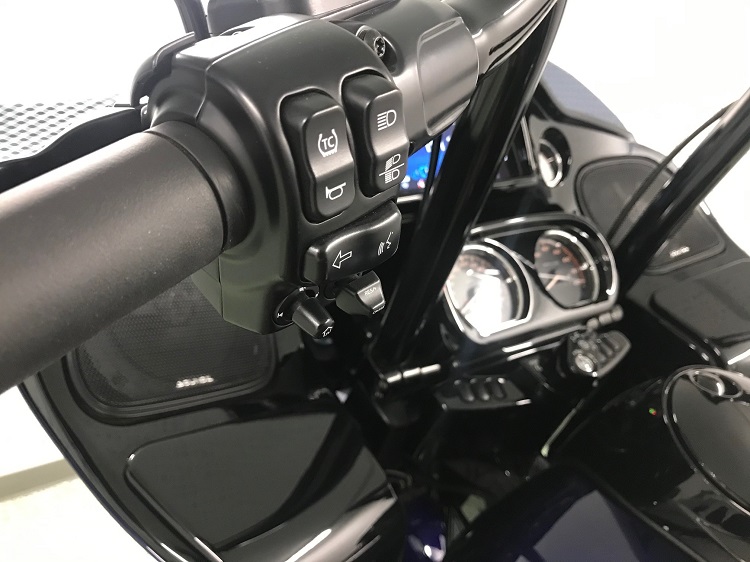What’s with that traction control switch? The Reflex Defensive Rider System otherwise known as “RDRS” on select 2020-later Harley-Davidson motorcycles is a new feature. It is designed to control engine power and braking based on available traction during acceleration, deceleration, and braking to allow the rider better control of the motorcycle.
EFI Tuning RDRS on Harley-Davidson motorcycles is different than other machines. However when understood and tuned properly the systems continue to operate as designed. Fuel Moto has tuned an extensive amount of RDRS equipped bikes. We own a RDRS equipped 2020 Road Glide for in-house calibration and product development. Very often we receive few inquires and questions on RDRS from customers and tuning shops and we’ve read some conflicting and incorrect information on various social media sites on how this affects tuning so we put together the following helpful info related to tuning with Dynojet Power Vision.
Tuning RDRS on Harley-Davidson Equipped Models
The H-D Motor Company starting using torque based throttle control several years ago in their OEM calibrations. With a torque based calibration the ECM effectively delivers fuel, spark timing, and electronic throttle control based on a torque model, what this means is the ECM follows the torque model while monitoring engine load, RPM, twist grip, and other inputs. It essentially determines how much power it’s going to allow. Primarily via the twist grip to % throttle blade relationship. This is done for several reasons; as a means to reduce throttle sensitivity and abruptness, to reduce driveline shock load and stress, and to limit power output when necessary.
Historically to get around this in our Power Vision tunes up to model year 2020 we’ve been able to simply turn off Torque based ETC tuning in the background and revert to conventional speed density tuning. However with the advent of RDRS this has changed. As this new system requires torque based throttle control remain active as the systems work hand in hand. While new to Harley, torque based tuning is commonplace among a broad range other platforms including several that Fuel Moto has supported for years. So this is not new to us and more specifically Dynojet and their engineers.
Watch for These Errors
We’re running into three areas where users are making errors when tuning RDRS equipped bikes. The first is loading a non-RDRS Power Vision calibration into a RDRS equipped bike, this does not work. It will set an assortment of engine codes. The CEL and Traction Control lights on the gauge cluster will remain lit, and RDRS will be non-functional.
The second issue is turning off Torque Based ETC in a Power Vision RDRS tune. Again this will set engine codes and RDRS will not function. Another common issue is tuning a cam or big bore application using a base tune that was developed for stock power levels (Stage 1 type tune). While you may not get codes or CEL’s, the power output will be reduced as the torque model does not match the engine output. We’ve seen cases where several of these errors were made in the same tune; not good.
Dyno Chart Example
The dyno chart below is an example of a RDRS equipped bike that was brought to us with a big bore kit (S&S 128″). It was built and dyno tuned by another shop. They used a tune based off a stage 1 RDRS Power Vision map (poorly tuned at that). In this chart engine torque is on the left Y axis, engine RPM the X axis, and the throttle blade is on the right Y axis. Note the throttle blade closing sharply at 5000 RPM’s. It is not opening 100% below 2800 RPM.

The Stage 1 calibration they started with does not have the correct torque model for the engine configuration in the above example. Initial power output and peak engine power were limited significantly by means of closing the throttle blade. The ECM saw engine power higher than the torque model. So it effectively shut the party down early. The nasty dip in torque from 2700-3500 was poorly tuned VE tables. Someone let it leave their shop this way.
Dyno Chart Example
The example below is the dyno chart for the same bike after a full dyno tune using a Fuel Moto developed Power Vision RDRS base calibration. We established the torque model, optimized the VE tables, spark timing, and other various edits and adjustments as part of the tuning process.

The chart below represents before and after, note throttle blade % and AFR.

For those looking for tuning RDRS on Harley-Davidsons, we have solutions. We have an extensive database of RDRS Dynojet Power Vision tunes and are continually adding to our database. Offering tuning support from basic to full remote tuning. Supplying Power Vision RDRS tunes with established torque models and other related tables. These are already configured to support most applications (from stock to extensively modified engines.) If you, your shop, or dyno tuner need assistance we can be contacted at 920-423-3309 or info@fuelmotousa.com. Feel free to visit our website too for more information: www.fuelmotousa.com.

